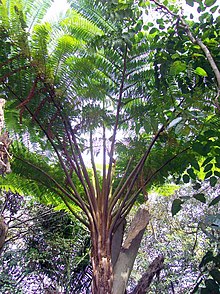Sphaeropteris excelsa
| Norfolk tree fern | |
|---|---|

| |
| Scientific classification | |
| Kingdom: | Plantae |
| Clade: | Tracheophytes |
| Division: | Polypodiophyta |
| Class: | Polypodiopsida |
| Order: | Cyatheales |
| Family: | Cyatheaceae |
| Genus: | Sphaeropteris |
| Species: | S. excelsa
|
| Binomial name | |
| Sphaeropteris excelsa (R.Br. ex Endl.) R.M.Tryon[1]
| |
| Synonyms[2] | |
| |
Sphaeropteris excelsa, synonym Cyathea brownii,[2] commonly known as the Norfolk tree fern or smooth tree fern, is probably the largest fern species in the world. It is endemic to Norfolk Island, in the Pacific Ocean near Australia and New Zealand. It is named after the botanist Robert Brown (1773-1858).
Description[edit]
In its natural habitat, Sphaeropteris excelsa is reported to reach 20 metres (66 ft) or more in height.[3] The broad, lance shaped, bipinnate-pinnatifid to tripinnate fronds can reach 5 metres (16 ft)) in length. Stipe is long and has a line of white, stitch like dashes along its length. Rachis and stipe are covered in white-brown and darker orange-brown scales. The trunk can become smooth with age and may display oval scars left from fallen fronds.[4]
Habitat[edit]

Sphaeropteris excelsa occurs naturally in subtropical rainforests on Norfolk Island. Average daytime temperatures reach around 23 °C (73 °F) during the summer months falling to around 17 °C (63 °F) during the winter. The highest temperatures likely to be experienced in this environment are around 29 °C (84 °F), the lowest around 6 °C. Relative humidity is fairly consistent at levels between 70 and 80% throughout the year. Yearly rainfall is approximately 1,200 millimetres (47 in).
- Conservation
The once extensive forests of Norfolk Island are now reduced to a single small forested area which has been designated part of a national park. Sphaeropteris excelsa is protected within this park. It is available in cultivation in many countries and though rare is not considered endangered.[5]
Cultivation[edit]
Sphaeropteris excelsa is cultivated as an ornamental tree. It requires a neutral to slightly acidic soil[6] rich in organic matter. The soil must be moisture retentive but well drained.[5] The tree fern will suffer if left to stand in waterlogged soil. Sphaeropteris excelsa requires high humidity and either high rainfall or frequent watering. During the summer months even a very young pot grown plant can consume 0.5 litres (0.13 US gal) of water per day.
Sphaeropteris excelsa requires good light but does best when shaded during the hottest parts of the day. It responds well to fertilization but can be intolerant of some commercial fertilizers producing malformed fronds and a larger but weaker plant. It is able to withstand only light frosts. Larger plants may survive overnight temperatures as low as minus three degrees Celsius.
In countries such as Britain it is best grown in a conservatory. Its large size however often makes this impractical. A beautiful and rewarding plant but in colder regions it is strictly for the more dedicated of enthusiasts.
It is easily grown from spore and can be very fast growing when young.
References[edit]
- ^ "Sphaeropteris excelsa (R.Br. ex Endl.) R.M.Tryon". Plants of the World Online. Royal Botanic Gardens, Kew. Retrieved 2019-08-23.
- ^ a b Hassler, Michael & Schmitt, Bernd (June 2019). "Sphaeropteris excelsa". Checklist of Ferns and Lycophytes of the World. Vol. 8. Retrieved 2019-08-23.
- ^ "Norfolk Tree Fern (Cyathea brownii)". Onszaden. Retrieved 24 November 2022.
- ^ Large, Mark F. & Braggins, John E. (2004). Tree Ferns. Timber Press. ISBN 978-0-88192-630-9.
- ^ a b "Sphaeropteris excelsa". San Francisco Botanical Garden. Retrieved 24 November 2022.
- ^ "Sphaeropteris Species, Norfolk Island Tree Fern, Norfolk Tree Fern, Smooth Tree Fern". Dave's Garden. Retrieved 28 February 2023.
